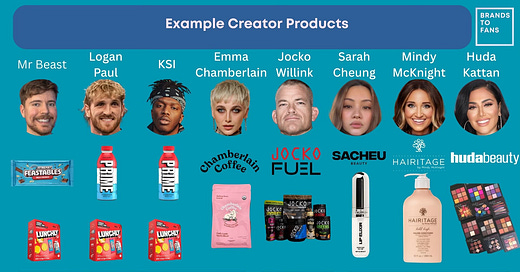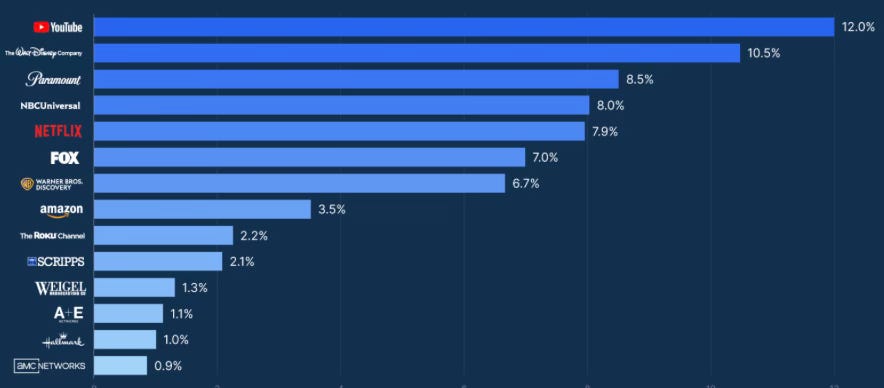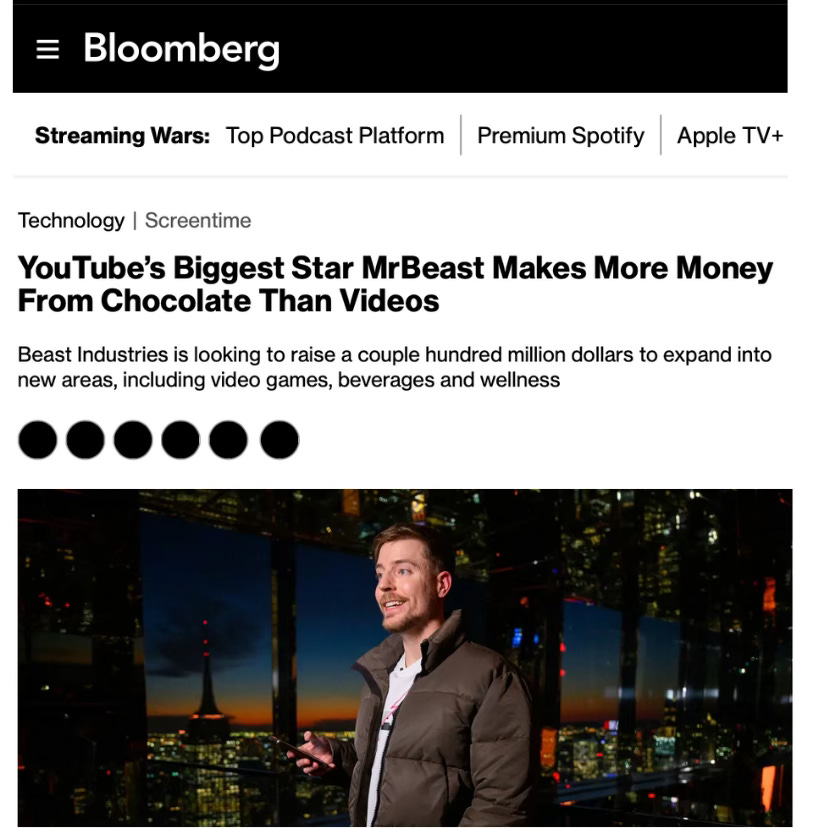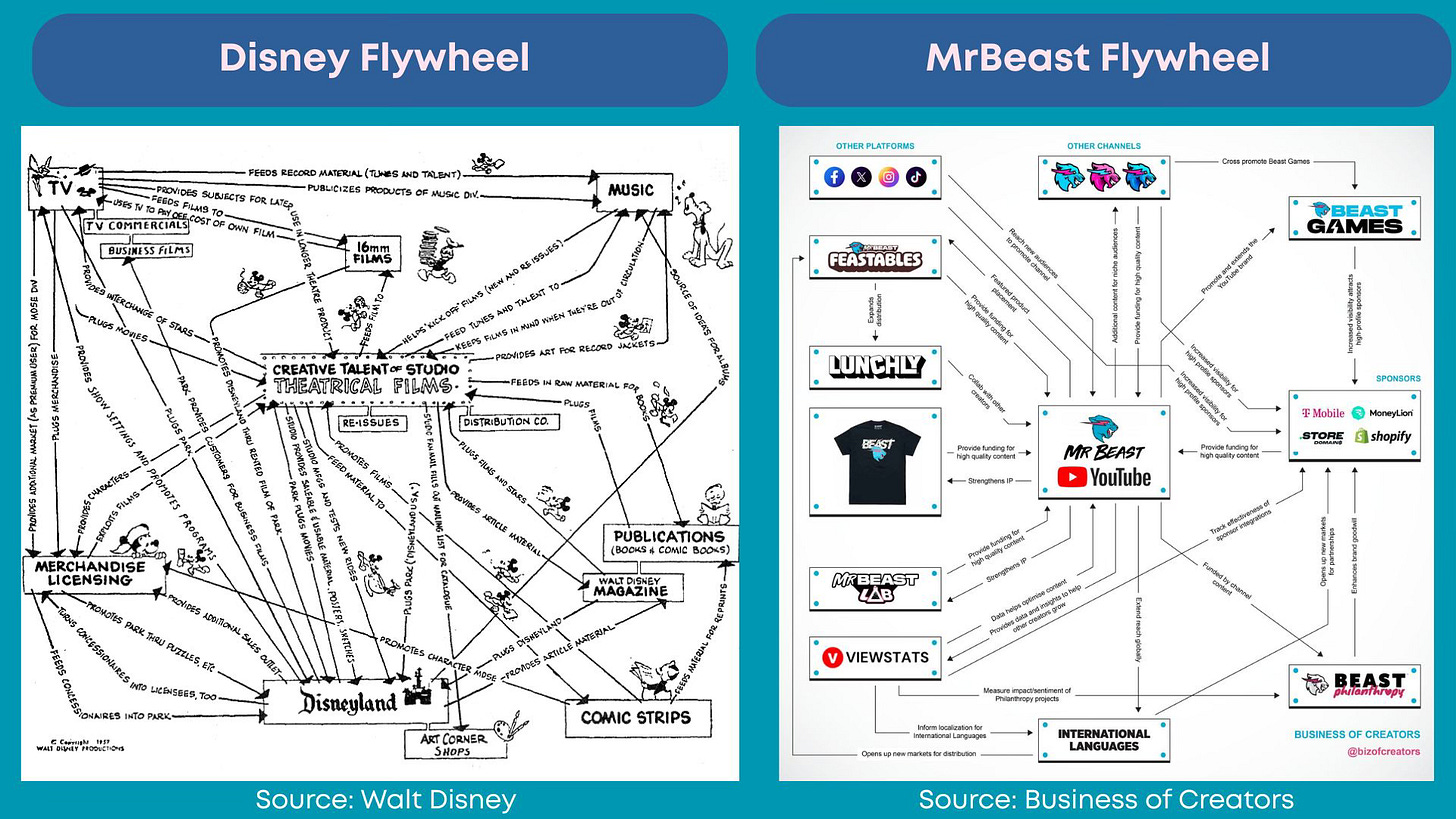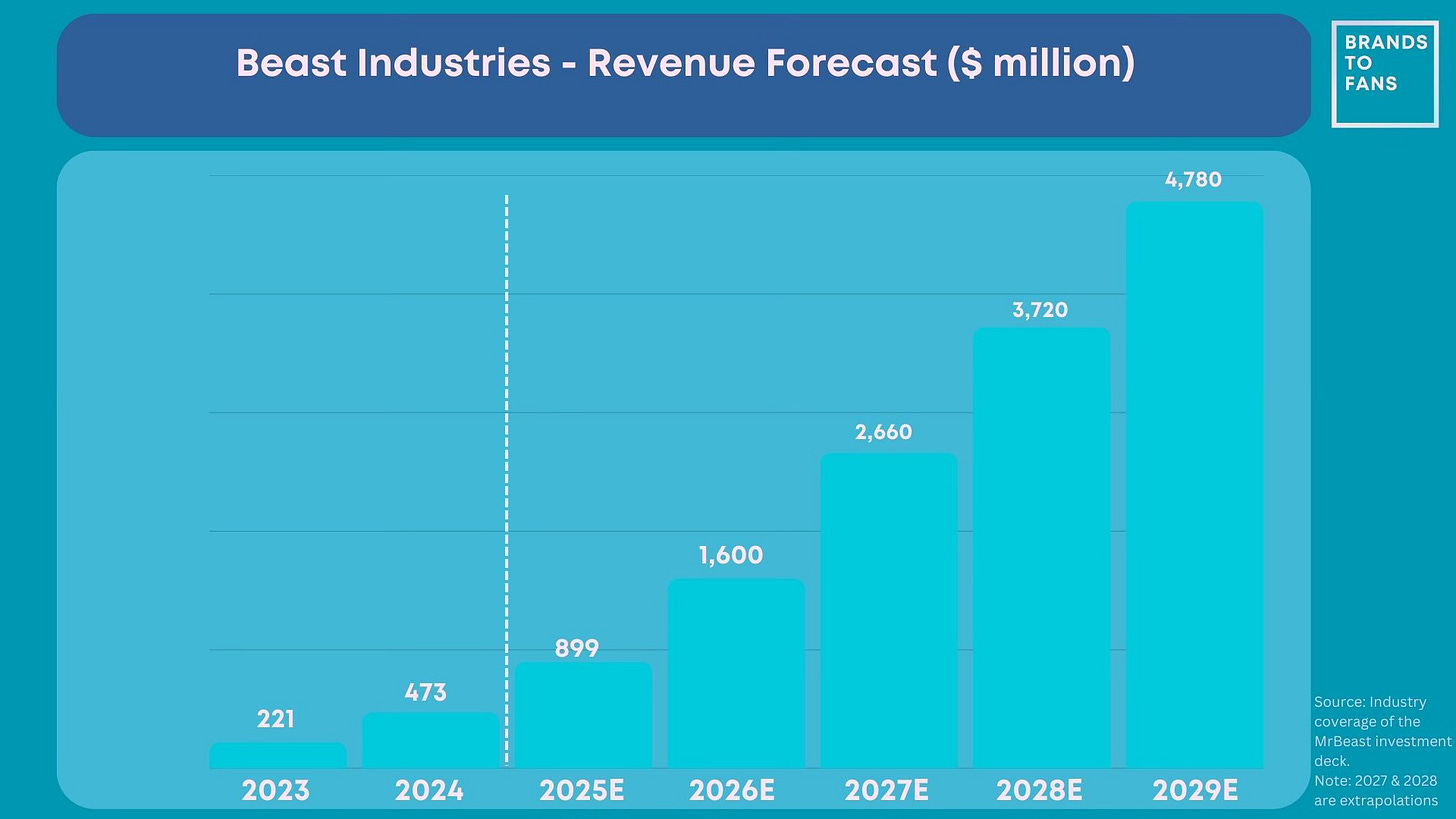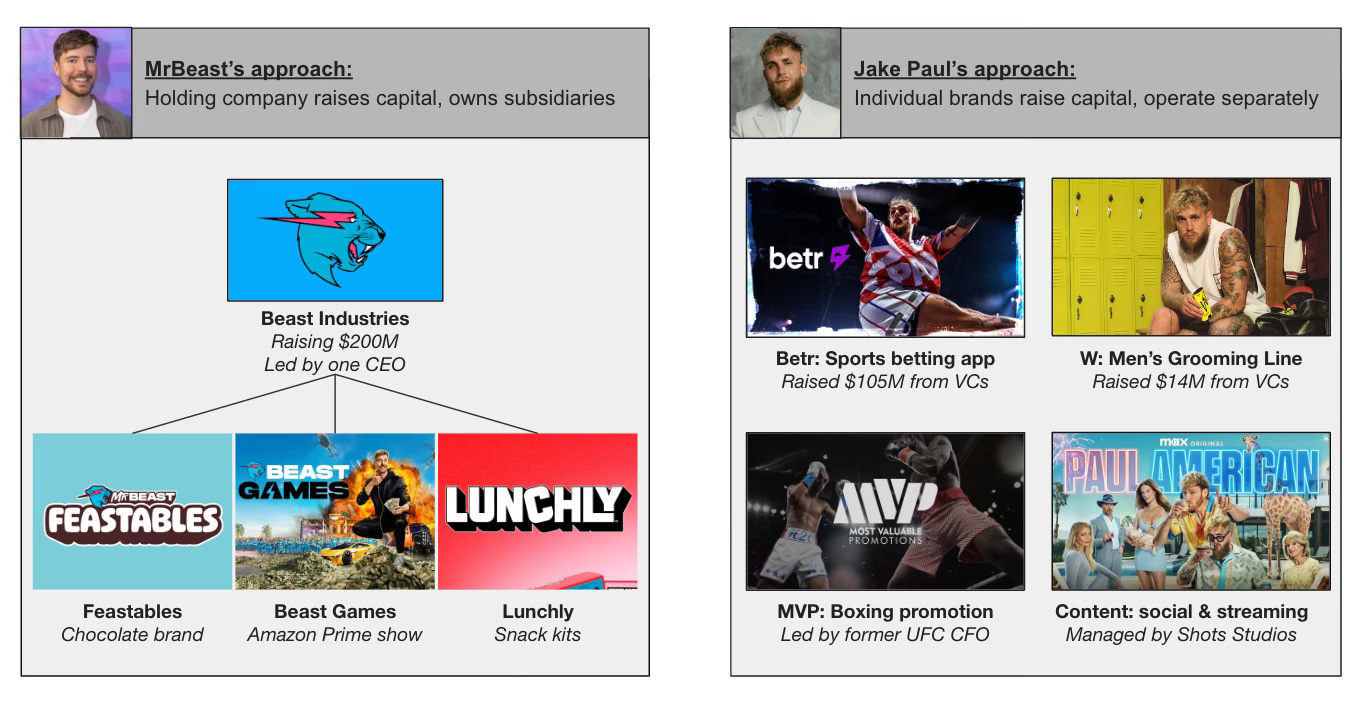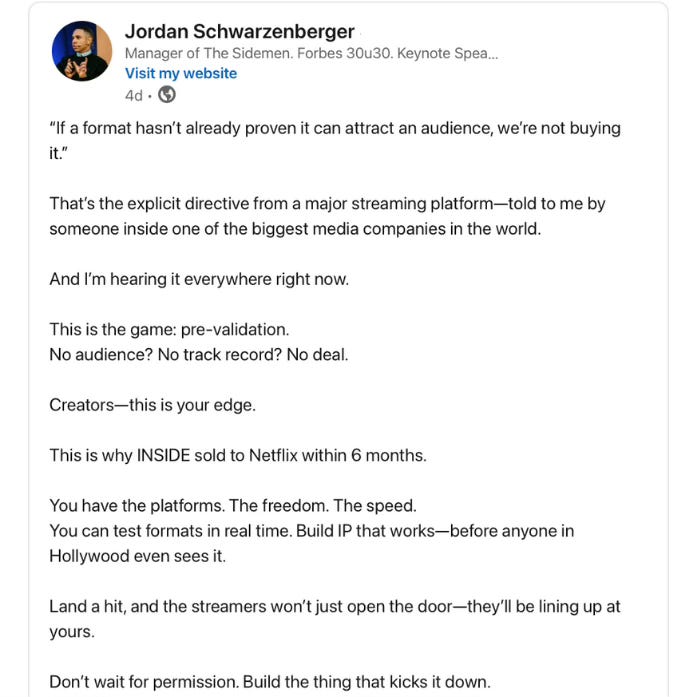I want to start by welcoming new readers this week - particularly those prompted to check us out at the recommendation of
, who cited Brands To Fans analysis three times in his recent post and declared it “one of my favourite new Substack newsletters”. As a big fan of his work, and a newbie at Substack who’s still getting used to posting into the void, this made my day! Those who’d like to receive future editions in their inbox, do click the button below.It’s a creator economy, we’re just living in it
While traditional media continues its existential crisis, the Creator Economy is booming. Goldman Sachs estimates it will grow to $500 billion by 2027.
As if to drive the point home, YouTube achieved a record 12% of all US TV viewing in March, making it the most watched distributor, ahead of Disney.
As this sector grows at speed, the opportunities for creators to monetise their brands are becoming increasingly sophisticated. The usual creator revenue streams of AdSense, sponsorship and brand partnerships remain a bedrock, but successful creators are:
Taking a leaf out of traditional media’s franchise flywheel playbook to launch spin-off revenue streams, and
Leveraging the unique dynamics of the creator economy to adapt this playbook and take it to the next level.
‘In our view, the diversification of revenue streams will continue to be a key theme for the creator economy in the coming years as creators explore new forms of media & platforms and expand their monetization offerings to recruit and retain their creator base.” - Goldman Sachs
What have creators learned from the traditional media flywheel?
Leverage content as marketing
In the same way traditional studios use their core products (such as movies) to market merchandise or theme parks, Creators use their high-reach content on platforms like YouTube or TikTok as a powerful, often loss-leading, marketing engine for their other ventures.
When an investment deck for MrBeast’s company, Beast Industries, leaked to the media last month, the main takeaway from the coverage was that his primary source of profit was not his videos but his chocolate business, Feastables, which achieved a profit of $20 million last year on sales of $250 million.
It’s clear that the entertainment wing of the company is increasingly a means of selling other products. “We have an unprecedented platform in terms of reach and fandom,” [Beast Industries CEO] Housenbold said. “We have the opportunity to launch multiple businesses on the back of that reach and distribution.” … Content and media are “a marketing investment in everything else we do,” Housenbold said. - Bloomberg
Sell stuff
The sector has matured from creators simply leveraging their reach to promote a 3rd party brand or product, to increasingly developing and selling their own range of Consumer Products, from Merch to Food & Beverage, and other categories that reflect their particular brands and audience interests.
Sometimes this is done in partnership with other creators, as with the Prime and Lunchly examples above, to amplify awareness and cross-pollinate audiences.
Cross promote
To continue to focus on MrBeast for a moment as the most extreme and successful example - his businesses include:
Feastibles - forecast to generate $375 million in net revenue in 2025.
Lunchly - packaged lunches, launched in partnership with Logan Paul and KSI. Generated $5 million in sales in their first 11 weeks on the shelves. Due to expand to 13 additional retailers in June 2025.
MrBeast Lab - toy business; drove $65 million in net sales within six months of launching.
Viewstats - a software firm that sells digital tools to fellow content creators.
Future areas for expansion are reported to include Health & Wellness (vitamins, electrolytes, and protein powder), Personal Care (soap, lotion, creams, and ointments), and Beverages. He is also exploring a video game platform, a loyalty program offering early video access and exclusive content to subscribers, a creator platform to help other YouTubers replicate his success, and a fintech offering dubbed Beast Financial.
In the classic flywheel model, each of these lines of business can serve to cross-promote and reinforce each other, creating an ecosystem of synergistic consumer touchpoints and brand moments. MrBeast's YouTube videos, for example, promote Feastables, which might include ads for his Amazon show Beast Games, which in turn will drive interest back to his YouTube videos.
The seminal articulation of this approach was sketched by Walt Disney in 1957, as shown below. I love how Ian Shepherd (from Electrify Video Partners and the Business of Creators podcast) has now recreated this for Beast Industries:
In success, this flywheel effect at scale can drive enormous revenues.
Raise capital and build integrated businesses
As successful creators become serious about scaling their businesses, many raise external capital to build and accelerate the flywheel.
MrBeast has raised $450 million to date and is reportedly rasing a further $200 million.
Dude Perfect achieved a $100 million raise last year, led by Highmount Capital.
Jake Paul raised $105 million for his betting platform Betr and $14 million for his grooming line W
VC firm Slow Ventures is explicitly tapping into this need with a $60 million fund to invest in businesses started by creators
The VC firm Will Ventures published an excellent analysis of the different approaches that creators have taken to their corporate structure, and their implications for capital raising.
While some, such as Jake Paul, have created separate corporate entities for their different ventures and raised separate pots of financing for each, others such as MrBeast are choosing a single ‘HoldCo’ structure to house all their ventures. This is much more like the traditional studio model, enabling the flywheel effect across verticals and aligning incentives between investors and creators across the whole business.
Centralise your offering and community
While Creators by definition publish content across multiple social platforms, many are simultaneously seeing the benefit of presenting a consolidated content offering for their fan base.
The Sidemen launched a subscription streaming service Side+ in 2021
£6.99/month or £69.99/year.
Offers community chat, loyalty rewards, and the full video archive plus exclusive content (5 series so far with weekly releases and extras). There are also monthly Zoom calls with The Sidemen, weekly Q&As, etc.
Dude Perfect launched the Dude Perfect App in 2024
Offers access to the entire Dude Perfect library, early access to new episodes, plus exclusive and behind-the-scenes content.
The app is entirely ad-supported, with no subscription element, and makes a point of only showing family-friendly ads.
Downloaded 2 million times in the first nine months.
This approach enables new monetisation opportunities and also provides the ability to control and brand the user environment in a way that can’t be done when syndicating content to third-party platforms.
In addition, it offers a level of first-party data and direct fan engagement that far exceeds what creators can expect from other platforms.
Expand your content to new formats
Many YouTube creators have extended naturally into podcasting (which itself has pivoted to video as a format) and livestreaming. Successful creators are keeping pace with changing audience consumption habits and meeting their fans where they are, in the formats that they most enjoy.
License your catalogue
As creators build up an archive of content, and as the production values of that content have improved over time with increased funding and improved technology and tools, we have reached a point where licensing deals with traditional media outlets for those catalogues become feasible. The boundaries between the two are really coming down.
YouTube star Ms Rachel licensed compilations of her pre-school videos to Netflix and scored a huge hit. As
of the Kids StreamerSphere newsletter explained:
“Ms. Rachel wins, all the way! Since dropping on Netflix in the US, as well as other territories, the YouTube educator has managed to feature in the Netflix Global Top 10 in 7 out of 12 weeks, including a four-week streak going from March into April. She’s also winning big on FlixPatrol Trending Points in all of the key English-speaking markets.” - Emily Horgan, The Kids StreamerSphere
Alan Chikin Chow has licensed content from his YouTube series Alan’s Universe to Roku Channel.
The streamer and distributor FilmRise launched a Creator Partner Programme back in 2021. Their curation team packages YouTube creator content into half-hour episodes, which it then licenses to streamers as well as placing them on FilmRise’s own streaming service.
In addition, there is now a potential opportunity for creators to license their catalogue (and even unpublished video) for the purpose of AI model training
Move into traditional media
It seems a short step from licensing catalogues to actually creating new shows for traditional media outlets, so it is not surprising that increasing numbers of creators are making this move.
MrBeast’s Beast Games may not have quite become the zeitgeist-defining smash hit that Amazon must have hoped for when it signed the reported $100 million deal, but it still generated 50 million views in its first 25 days and is currently casting for its second season.
Logan and Jake Paul’s Reality Show ‘Paul American’ has just launched on Max (Variety says it is “Loud, Obnoxious — and a Perfect Fit for Trump’s America”)
YouTube dating series Pop The Balloon has landed a live Netflix order.
The Sidemen migrated their reality competition series Inside to Netflix for its second season.
Streamers have realised that the only way they can compete with YouTube is to open the cheque book for its content and run it on their own platforms. [Inside] is a British reality show that premiered on YouTube last year. Every episode got more viewers than anything shown on BBC One, so Netflix quickly snapped up the rights to the second season. Inside will be watched by so many people that it’s almost pointless for me to tell you whether it’s any good or not. - The Guardian
Netflix have also signed podcast host Tony Hinchcliffe for 3 specials based on his format Kill Tony. Hinchliffe said:
“It all started in a room at The Comedy Store with 12 audience members and barely anyone watching in 2013. After 700+ Monday releases on YouTube it seems the persistence has paid off … The creative freedom given to us by Netflix to keep the show in its pure form is a comedian’s dream” - Hollywood Reporter
Ted Sarandos expounded on this trend on the last Netflix earnings call:
“Is it premium? Well, some of it is, and we believe we have the best monetization model on the planet for premium storytelling. I think we could help those creators reach an audience. Our model can also support more ambitious efforts for them, could help derisk them … We’re looking for the next generation of great creators, and we’re looking everywhere. So they’re not just in film schools, and certainly not just in Hollywood. Creators today have tools that were unimaginable a decade ago, you know, to tell stories, to reach audiences.”
Take it to the real world
Just as traditional media businesses extend their brands with real-world experiences (theme parks, fan conventions, live shows), so too are creators taking their brands from online to IRL.
Live Nation recently acquired a majority stake in the influencer talent management firm Timeline to help expand the creator touring business.
Dude Perfect are planning their fifth tour this Summer, including 20,000 capacity venues and dates in the UK & Ireland. In addition, they plan to extend their new state-of-the-art studio facility to add a merchandise shop and consumer experience (according to the Like & Subscribe newsletter, which I highly recommend).
The creator ‘edge’ vs traditional media
As the creator economy continues its inexorable growth, it is leveraging some unique attributes that give it quite an advantage over some traditional media.
Audience ownership and direct relationships
Unlike traditional media companies, which often don't own the relationship with their viewers, creators are focused on building and nurturing direct relationships and communities with their fans. They prioritise making content that resonates directly with their specific audience's interests and values, leveraging detailed audience insights and community feedback.
Platforms like Patreon and Substack enable direct connection and monetisation, bypassing traditional distribution gatekeepers.
The intimacy of the creator-fan relationship, and the parasocial dynamics that can result, often lead to deeper fan connections than traditional media can hope for. Deloitte’s 2025 Digital Media Trends report found that 50% of Gen Zs and Millennials surveyed say they feel a stronger personal connection to social media creators than they do with TV personalities or actors.
This connection can burnish a creator’s brand with a high level of authenticity, and establish a trust with their audience that greatly improves the odds of their future business intiatives succeeding.
Direct fan relationships maintained through social media, email lists, e-commerce, subscription billing relationships and owned apps also provide a trove of fan data that can be leveraged to inform future business initiatives.
Agility and speed in testing
As digital-first producers, creators can test content formats and business ideas in real-time on social platforms without waiting for external permission or extensive corporate approval processes. This allows them to identify and validate popular concepts before investing heavily.
Indeed, when it comes to moving into traditional media, the increasing insistence from commissioners that shows are somehow pre-validated lends itself perfectly to these creator economy advantages. As Sidemen manager Jordan Schwarzenberger explains it:
Leveraging technology
Creators are quick to adopt new technologies like AI for content creation, translation, editing, and automating business functions, enabling cheaper and faster production.
Instant global reach
Traditional media’s ability to scale globally is sometimes constrained by the territory-rights profiles that have been dictated by their funding models.
In contrast, creators can scale globally at speed - particularly now that AI-driven Multi-Language Audio Tracks (MLA) can enable them to publish in multiple languages from launch. MrBeast disclosed in an interview on Colin and Samir’s YouTube channel that 70% of his viewership is from outside the US.
But - it’s not all smooth sailing
In case all the above sounds too utopian, it’s important to acknowledge: scaling businesses this complex is hard! For many creators, the journey from bedroom vlogger to portfolio entrepreneur is fraught with executional risk.
Not every product launch succeeds, and it is crucial to select the right partners. Jimmy Donaldson (MrBeast) ended up suing the company behind his fast food chain, MrBeast Burger, for making ‘inedible’ food.
Quality control is key. The very online social media dynamics that drive the success of these creators can end up amplifying the fallout from any missteps that are made.
When Emma Chamberlain expanded her Chamberlain Coffee business into new categories and stores, problems with its co-packer meant some of its products weren’t available for months.
In a fast-moving, social-media-driven environment, launching a new product successfully is one thing, but sustaining it beyond the initial hype cycle can be another. Prime Hydration achieved over $250 million in revenue in its first year, but then sales in its second year were reported to be falling by 50%
The need to professionalise operations has led many creators to implement management structures that start to look a lot like … traditional media companies.
MrBeast hired venture capitalist Jeffrey Housenbold to serve as president and chief executive officer of Beast Industries. Housenbold has since filled out the executive team with a Chief Financial Officer, a Chief People Officer and a General Counsel while also building teams for brand partnerships and strategy. Ahead of a potential initial public offering, he’s now attempting to professionalize the business, clean up some of the spending waste and expand into new areas. Housenbold says he will cut an estimated $100 million in costs this year while turning the company into a profitable business ... He attributes past losses to the kind of mistakes that startups often make early on when they are rapidly expanding. - Bloomberg
In October 2024 Dude Perfect appointed former NBA executive Andrew Yaffe as CEO, and subsequently hired a Fanatics veteran as CFO and a Chief Product Officer from Varsity Spirit.
How to scale beyond the creator bottleneck
Successful creators now face the challenge of how to scale their brands and business beyond themselves.
Dude Perfect are not going to want be doing trick shots forever. In an interview with Like & Subscribe, they said:
“We are still really enjoying being on camera, but one day we hope that this brand will mean something to families outside of just the five of us.” - Coby Cotton, Co-founder, Dude Perfect
“None of us are getting any younger, unfortunately; we’ve all had surgeries and labrums replaced. There’s a whole next generation of what Dude Perfect can mean from a content perspective.” - Andrew Yaffe, Dude Perfect CEO
As an example of what this means, Dude Perfect just hosted, without competing themselves, the first Dude Perfect Trick Shot World Championship, with eight of the world’s best trick shot teams competing for top honours.
Similarly, Emma Chamberlain grapples with reducing the dependencies of her coffee brand:
“My goal is to make Chamberlain Coffee a real brand that people like without me in the picture. I do want it to have a life outside of me. What’s gut-wrenching about that is that it might not. That’s my goal but it might not. And that’s the thing with anything entrepreneurial, it is fucking cutthroat.” - Emma Chamberlain (reported in Like & Subscribe)
MrBeast’s investment deck also made it clear that he is exploring ways to be off-camera. An in-house writers' room (with backgrounds in novels, gaming, comics, TV, and film) is reportedly developing "Beast Universe" IP for licensing across toys, gaming, comics, and merch.
It starts to look a lot like a studio, doesn’t it?
Thank you for reading! No news roundup this week, but I’ll manage a double-dose in the next edition 😁.

